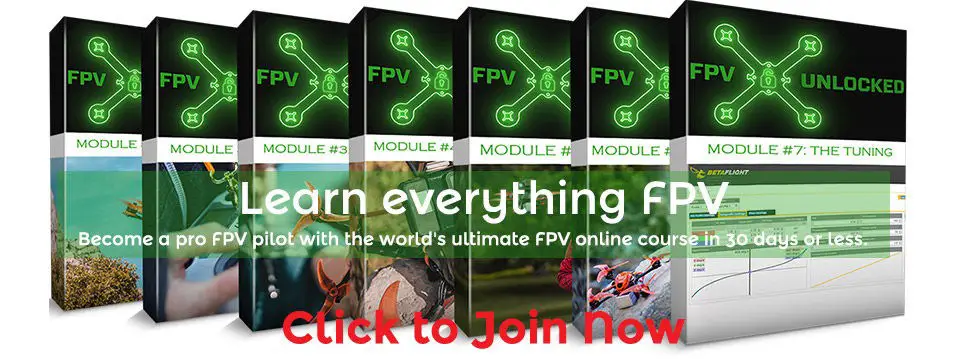Drone racing is an emerging competitive sport that has gained more and more popularity in recent years. It is tempting to start an FPV racing career, but how can you make your way there?
To become a professional FPV racer, you need to dedicate yourself to continuous practice, learn the necessary skills and regulations, obtain the required licenses, and network within the community to attract sponsorships.
There are a lot of things to consider and different paths toward a professional drone racing career. What I am laying down here is what I believe is the easiest to execute with minimum cost, especially if you have a day job! While there is no guarantee that you will be successful in this career following this route, you will be pretty close.

Are You Sure You Want to be A Professional Drone Racer?
This is the question that you should first ask yourself. The path towards professional drone racing is surely not an easy one and you will be faced with various hurdles throughout your career. You will definitely need determination and spend a lot of efforts to be successful in this path.
Many people are skeptical towards a professional career in drone racing given it is relatively new. You will be questioned by your family and loved one whether the effort and dedication that you are putting on will eventually pay off.
But if you’re set on taking a leap of faith and grabbing that risk by its rear-end, great!
Choose A League to Start with
As a drone racer, you would have to participate in competitions to gather experience and boost your skills and status in the community. There are several competitions that you could enter, and each one will have varying rules and regulations – making it necessary to examine all of them first before simply diving into one specific tournament.
The most popular league for aspiring racers today is MultiGP. It is the largest professional drone racing league in the world, built on a foundation of local chapters and a global community. MultiGP’s greatest strength is its accessibility. You can find a local chapter in your area to start racing with other pilots, get hands-on experience, and test your skills in a friendly environment. The league hosts regional and national championships, including the MultiGP International Open, which is a major event for pilots of all skill levels. This grassroots approach allows you to climb the ranks from a local pilot to a nationally recognized competitor.
Another major international league is the Drone Champions League (DCL), which focuses on both live and virtual racing. DCL hosts a series of high-profile events around the world. Similar to the now-cancelled DRL model, they rely on virtual qualifiers to select pilots for their professional teams.
While the Drone Racing League (DRL) has been a prominent name, its 2025 season was canceled without explanation. This highlights the unpredictable nature of professional leagues and the importance of having a solid foundation in the sport.
Regardless of the league you choose, getting started on a simulator is still the most cost-effective and efficient way to practice. Why a simulator? The answer is simple. First, you get to practice without spending too much. Drone racing is expensive considering the initial investment, replacement cost, upgrade cost, and running cost. While you are learning and pushing your limit, you will certainly crash and would need to replace your damaged drone. You don’t have to worry about those costs with a simulator.
Secondly, many leagues, like MultiGP (Verocidrone) and DCL, use official simulator tracks for their global qualifiers. You can climb the ladder while practicing from the comfort of your home.
Thirdly, because racing in a simulator can be done anywhere and anytime without affecting your day job. This is especially crucial for those with heavy financial commitments.
Keep Practicing
Unless you are talented in drone racing, you will need a lot of practices.
So how much time can you allocate each day for practicing? 2 hours? 30 minutes? Most people have a day job or school and family commitment. We don’t have too much time to spend on practicing.
Regardless of how much time you plan to spend on training, make a schedule and follow it! It can be 30 minutes daily or 20 hours a week. Just make sure you are consistent.
Most importantly, have fun every time you fly. Otherwise, you will eventually get sick on training and give up your dream.
Learn the Knowledge and Get the Licenses
A drone itself is a technology that utilizes different areas of knowledge which include radio, aerodynamic, engineering and so on. While you don’t need to know everything inside out about drones, you do need to have some knowledge on the underpinning technology or mechanisms of the drone. On top of that, you also need to know the rules governing drones.
Some of the basic knowledge is covered when you study and register for a Remote Pilot Certificate by the Federal Aviation Administration (FAA) and Ham Radio License by the Federal Communication Commission, while some require you to learn from hands on experience or learning online.
You should prepare to register yourself with the FAA Part 107 (also known as the Small UAS Rule), as you will eventually fly outside the simulator. You will need to register your drone with the FAA and get your licenses if you plan to fly for professional or commercial purposes. That includes making money from racing, videos, or sponsorships.
Equip Yourself with the Real Drone Set
At some point, get yourself a good radio transmitter for your simulation. In fact you should get it as soon as possible. The only reason I didn’t recommend you to buy it earlier is to save you some money, in case you’ve changed your mind after a few simulations.
You can refer to this guide to learn how to choose a radio transmitter.
You will need to get yourself familiar with a real RC controller because its design is so different from a keyboard or a gaming controller. Once you get used to it, start to buy or build your own drone, and an FPV goggle of course.
While you continue to practice through simulation, fly your drone regularly. You need to be familiar with flying a physical drone, managing batteries, changing parts and etc. Remember, you will eventually fly a physical drone in a race so you need to know how to deal with different scenarios.
Participate in Real Life Racing More Experience and Networking
You want to be a drone champion, not a video game champion. There is no point claiming yourself a drone racing professional if you can’t beat anyone outside the simulator.
As you get better in racing, you should start joining local, national, and even international races. The MultiGP Drone Racing league is a good option as it hosts regional, national, and international racing championships that you can compete in. If you think you are not ready for that, you can join a local chapter to test your skill in community racing.

A real drone racing feels very different from a virtual one. You no longer sit on your coach comfortably and focus on your race. Instead, you see opponents and audiences face to face. Their cheering, gestures and actions can give you enormous pressure than what you would face in the simulator. If you can’t get used to that, it will be tough for you to perform well when you are drafted for the DRL seasons.
In a real race, you will also encounter situations which you would never encounter in the simulations. For instance, your video transmitter may stop working, your drone refuses to pair with your controller etc. All these are good learnings that make you a better drone racing professional.
On top of that, participating in various races is a good way to build your network. In races, you get to know new friends whom you can learn from and potential sponsors whom you may work with in future. You might impress someone in a race so much that they decide to sponsor you, who knows.
If you manage to get sponsorships, you can potentially convert to full time and spend more time in racing. A full time racer spends up to 10 hours a day practicing. Unless you are already rich, the only way for you to allocate so much time for practicing is by having sponsorship.
Push Your Limits
“If you don’t crash, you are probably not trying hard enough”. This is a popular saying in the FPV drone community. While it is not necessarily correct, fears of crashes will definitely hold you back from improving.
You need to be ready to leave your comfort zone and challenge yourself so that you can reach a new horizon. Don’t be afraid of crashing in your attempts. Once you’ve reached a new level, celebrate and continue to challenge this new limit.
While it is crucial to push your limit, don’t overdo it. Overtraining can cause injury even for drone racers, especially on the wrists or hands. If you are tired, rest! Drone racing career is a long journey and you shouldn’t sacrifice your long term interest for a short term gain.
Final Thoughts
Establishing a career in an emerging field is a nerve-racking risk that no one would deny. It is hard to say where we will end up after a few years or so. However, there is no need to worry whether you’re making the right decision or not, or if you’re going to thrive well in this area. The only thing left to do is take a leap of faith. A decade ago, drones were not even known to many individuals. Now, it is steadily receiving attention and following. Who knows what the field of drone racing has for us in the following years?



